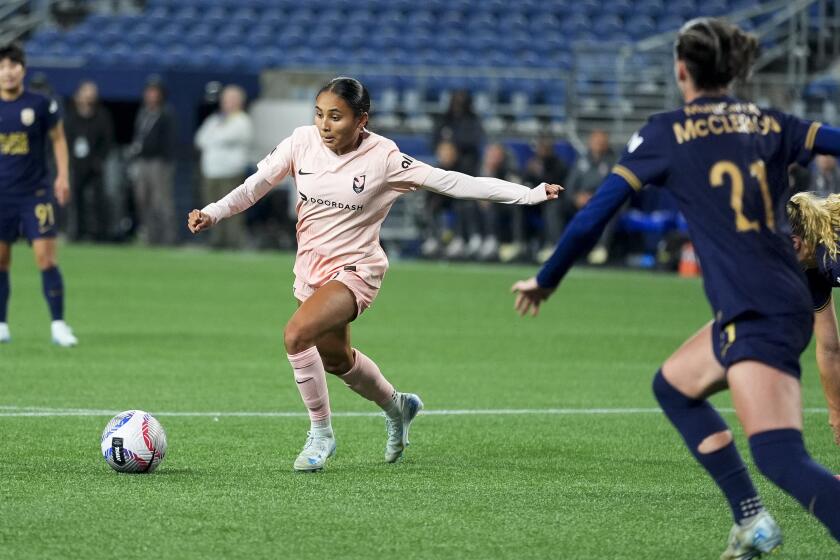SPECIAL REPORT / SOCCER IN AMERICA : NASL Boom/Bust A Poor Role Model : History: Cosmos had to go for big foreign names, but MLS will try to succeed on the American plan.
- Share via
The New York Cosmos did everything in a big way. The franchise’s collapse was no different. From 1975 to the early 1980s, the Cosmos were the flagship franchise of the North American Soccer League, America’s first and last major outdoor professional soccer league.
When the Cosmos failed, the league failed with them, and with the league went all of soccer’s credibility as marketable entertainment in the United States, the world’s largest entertainment market.
In their heyday, the Cosmos played before crowds of more than 70,000 in Giants Stadium in East Rutherford, N.J. They had international star power--at one time the Cosmos had 14 nationalities represented on their roster. And they had Pele.
They were New York, and they were huge.
And anyone with links to the team is still blamed for ruining soccer in America.
Mark Brickley, the president of Sportslink, a New York sports promotional firm, was the vice president of broadcasting and public relations for the Cosmos, and he still is defensive about the team.
“We didn’t consider ourselves to be competing with (NASL franchises in) Tulsa and Tampa Bay,” Brickley said. “We were competing with the Yankees and the Mets and Lincoln Center.”
The Cosmos drew 70,000 by signing Pele, Franz Beckenbauer and Giorgio Chinaglia, former World Cup stars whose skills were diminished when they arrived in New York, but whose drawing power was not.
“We felt, if we’re going to do it, we have to get the big-time guys,” Brickley said. “We knew that (the NASL) would not work on a minor league level. Our ethnic fan base demanded the big-time names.”
The Cosmos were owned by Warner Communications, which could afford high-priced international talent. The rest of the league, largely owned by individuals or small-time partnerships struggling to fill modest payrolls, was outclassed.
Said Brickley, “They’d say, ‘Well, we can’t be the NFL, but since my kid plays soccer, we can be the Houston or Memphis NASL team.’ Those owners that tried to keep up quickly went belly up.
“We didn’t think they needed to. No league has ever done badly with a dynasty in it. All leagues have to have somebody to hate, like the Yankees or Green Bay in their heyday.”
With Warner pumping money into the roster, the Cosmos won four championships in six years, and the rest of the league, which fluctuated from a peak of 24 teams to a low of five, had to do something.
Trying to keep pace, team after team burned itself out.
Peter Wall played briefly in the NASL before becoming the coach of the now-defunct California Surf and L.A. Lazers.
“The NASL was one of the reasons I came from England,” Wall said. “When the Cosmos brought in the stars, it pushed the average salary up. The (Cosmos’) salaries were used as a comparison, just like any other sport.”
Since the NASL, American fans have seen leagues of all shapes and sizes come and go. None have brought soccer to the national consciousness, or even network TV, the way the NASL tried to.
“We made some critical mistakes, chief among them expanding from 12 to 24 teams without researching and carefully planning the ownership groups,” Brickley said. “Then (when a franchise failed) you couldn’t go back into those cities because you’ve left a bad taste in their mouth.”
Now comes Major League Soccer, the first attempt at a high-profile pro league since the NASL.
The MLS is already ahead of the NASL in some ways.
NASL TV advertising was sold locally. The MLS is recruiting national sponsors. The NASL was destructively cavalier about ownership, but the MLS is showing selectivity: Only seven of the 12 franchises have been awarded with no evident rush to get out the last five.
And Wall now sees a major appeal for the MLS that the NASL never had: home-grown talent.
“In the NASL, you had only to play two American-born players. I honestly believe now that there is more than enough talent in America. And fans obviously would rather follow Americans.”






